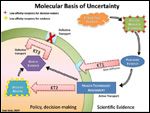The Role of Patients, Clinicians, and Payers in Comparative Effectiveness Research
Speaking at the ACCC last Friday, Sean Tunis, founder and director of the Center for Medical Technology Policy, gave a basic primer on what he sees as the primary goal of comparative effectiveness research.
Speaking at the ACCC last Friday, Sean Tunis, founder and director of the Center for Medical Technology Policy, gave a basic primer on what he sees as the primary goals of comparative effectiveness research (CER). First, to provide more evidence-based, scientifically driven, clinical practice in policy, and second, to have some positive impact over time on the trend in healthcare spending.
SLIDES
Click above to view a PDF of Sean Tunis's presentation from ACCC
Tunis acknowledged that there is a widespread concern that “clinical autonomy is potentially perceived as being threatened by this,” but said that a policy goal for those involved in developing CER is to maintain clinician autonomy and a respect for individual patient preferences.
Another critical part of the anxiety that surrounds CER is the concern that financial incentives for innovations in healthcare will be threatened. “It’s thought that CER will be a damper on this innovation," said Tunis, "especially since the life sciences industry is probably one of the few remaining healthy American industries, so its contribution to the economy is important to preserve.”
Tunis sought to address the question “How is CER different from how we do research today, and how much of it depends on the active participation of the clinical community in making sure it’s done successfully?” He began by saying that often Medicare decisions are made based on a paucity of clinical data. “Every year there are 18,000 new randomized trials, tens of thousands of non-experimental observational studies, and virtually every systematic review that’s done that’s intended to inform clinical and health policy decision making routinely concludes that the evidence is inadequate.” He pointed out that there is often a disconnect between what the reviewers are looking for and what the clinicians are providing, and said that the theory behind CER is that these gaps in evidence will be reduced if there is greater engagement between patients, clinicians, and payers.
CER can lead us to a next generation of evidence that’s of higher quality, believes Tunis, which will help doctors take better care of patients. As an example, he showed a set of guidelines on the treatment of Alzheimers from the American College of Physicians. The guidelines looked at five drugs that were FDA-approved for dementia, based on improvement in cognitive function. The ACP guideline determined that the evidence was weak, and pointed out specifically that there was no comparative information, and that the outcomes of the trials were not outcomes that clinicians use to assess patients in routine practice.
Tunis argued that a mechanism is needed by which these insights about the deficiency in the current evidence base are actually factored back into the next generation of trials. He stated that “the people who know what the most clinically important outcomes are, are the people seeing patients every day, which is why clinicians will play such an important role in CER.” He also noted the importance of patient insights in this process.
Tunis added that CER “will create a mechanism for developing methodological standards where the clinical community, the patient community, and the payers are consulted about what information is actually most important to them in terms of making clinical and policy decisions.”
The CMTP is currently working on an effectiveness guidance document on patient-reported outcomes in oncology trials, to be ready in April or May of this year. Their goal is to “define a minimum set of specific patient-reported outcomes that will be included in all trials of off-label use of cancer drugs, many of which are phase II trials. The goal is to propose standard timing and a process for collecting this data, and consulting with patients and clinicians and payers, determine what the most important patient reported outcomes would be to include in these trials.
Tunis wrapped up his presentation with the statement that, “In my view, one could be agnostic about how you fix the healthcare system…but all of this depends on having reliable scientific information about what works and doesn’t work, and in whom.”
